Happy New Year everyone! this will be my first review for 2019!
Back in the late Eocene, the world’s oceans were a much warmer, shallower than they are today. If you took a stroll along the beach back then, you may think that you have stepped into some hidden tropical paradise somewhere in the tropical pacific.
It is only when you notice some of the oceans inhabitant will you realize that you are in a completely different time.
Instead of the frolicking dolphins one may encounter in todays oceans, some of these inhabitants were strange and huge.
Take Basilosaurus. At first glance, one might think that they are looking at a remnants from the age of the dinosaur, a marine reptile. In fact, the name Basilosaurus means “King Lizard”, but in fact this strange animal is a genus of prehistoric whale.

You can’t blame those early paleontologist who gave it the name King Lizard, after all, this animal looks a lot more like those marine reptiles than a whale. How confusing it must have been!
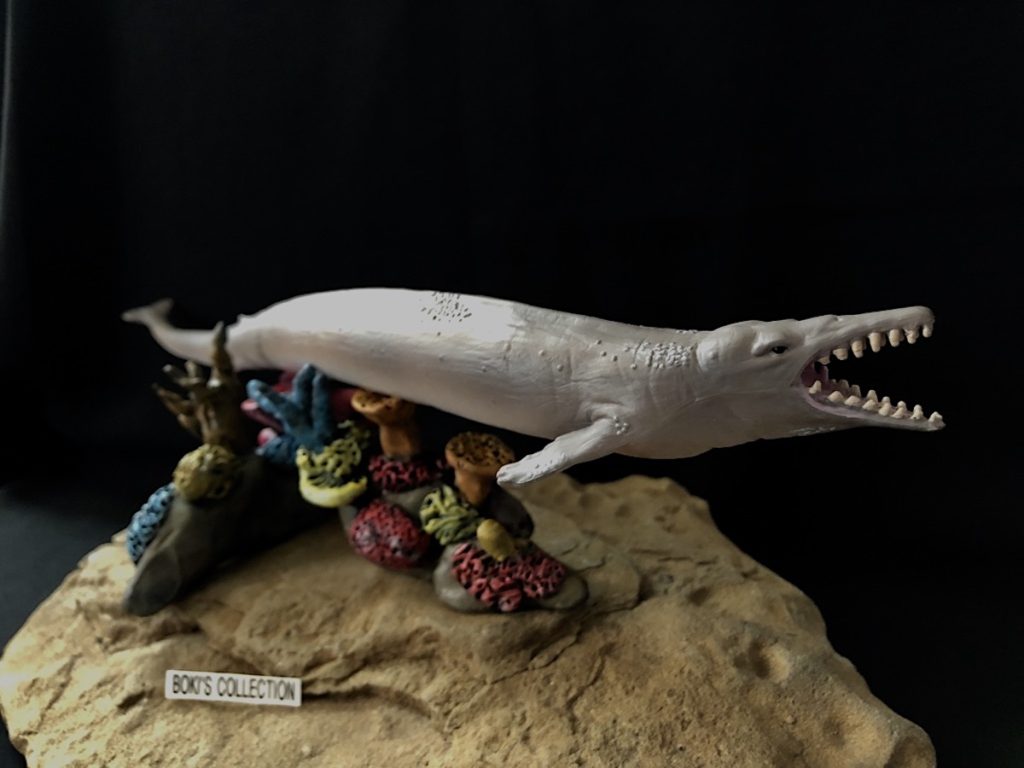
It was not until Sir Richard Owen studied the fossil that it was confirmed that the animal is not a marine reptile but a mammal.
With the demise of those fearsome marine reptiles that used to rule and terrorize the world’s oceans, a new cast of characters quickly moved in to fill in those empty spots.
All whales, extinct and extant, including Basilosaurus evolved from terrestrial mammals like the odd looking Ambulocetus.
Looking closely, one can see these evidence in the flippers of Basilosaurus. The flippers still has the distinctive elbow joints.
There are many different species of prehistoric whales, but Basilosaurus is one of the largest of them, reaching some 49-59 feet long!
There are two species of Basilosaurus, B.isis and B. Cetoiodes, with the latter being the larger of the two. B.isis dominated the seas that once covered what is now Africa and the middle East, while B. cetoides terrorized the seas of what would one day be North America.
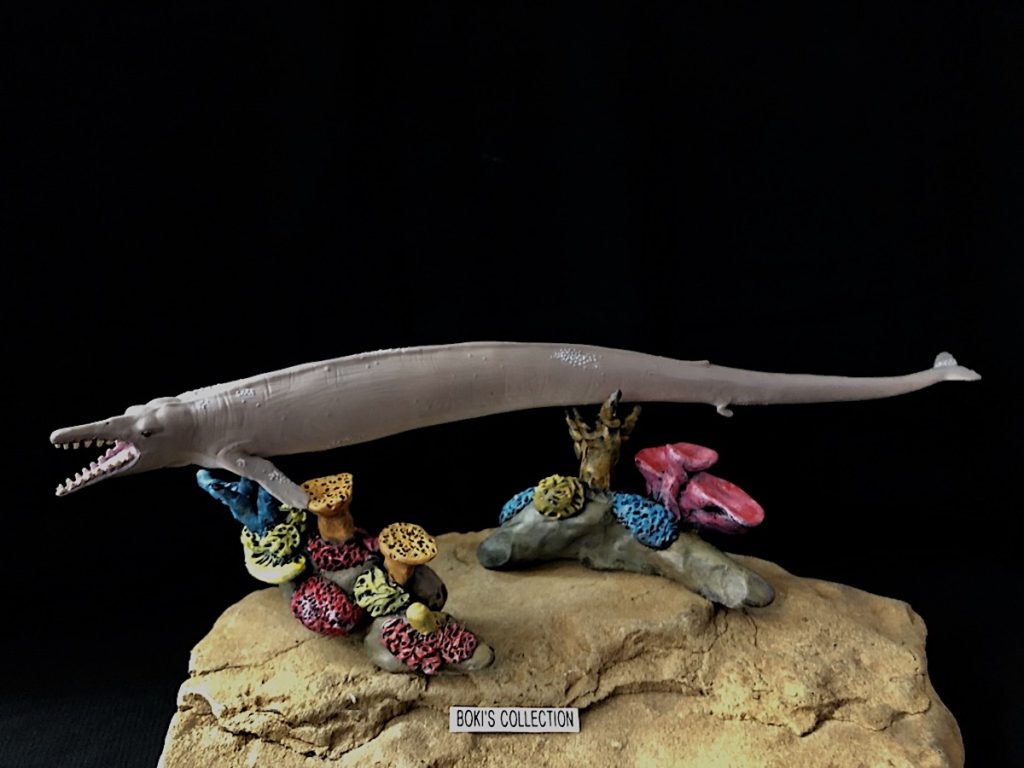
Basilosaurus has attained some fame, thanks to its starring role in WWPB, that wonderful BBC series documentary that brought some of the most iconic prehistoric creatures to life.
But despite these new found fame, it remained one of the most overlooked prehistoric animal by the major brands that produce prehistoric toy figures.
It is one of the few prehistoric mammals that, year after year, would make it to the top ten of the most requested and hoped for by the dinosaur toy collector community.
There are only handful toy figure of this animal, and most of them are small and often extremely hard to obtain. That all change when, back in 2016 , the newly emerged Chinese company PNSO released a large, truly impressive figure of Basilosaurus, which I had the pleasure of also reviewing it for the blog (maybe I can review all the available models I own, just a thought haha)
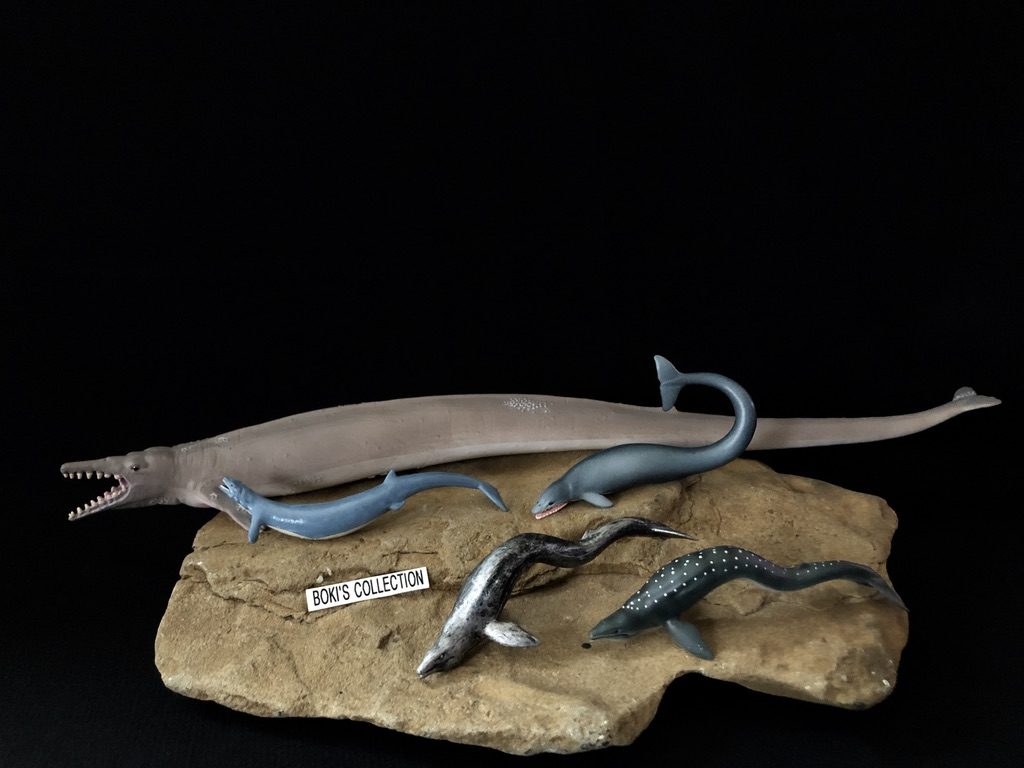
The following year, CollectA finally released their own version of this mighty whale, the subject of this review.
Part of CollectA’s standard range of figures, which in most cases are within the 1:40-45 scale. The figure measure a good 14 inches long and fits the 1:45 scale. This is perhaps one of the longest standard figure from CollectA.

Looking at the head, it is recognizable as Basilosaurus, in fact if you superimpose a picture of the skull, it fits nicely. The teeth are individually sculpted and painted light gray-brown. The paint job on these teeth is nice and clean considering how small they are.
If you look inside the mouth, you will see that the tongue is also nicely sculpted. The inside of the mouth is painted a dark pinkish color.The snout is pointed as it should. You can see the small nostrils on top of the snout, just between the tip and the eyes. The eyes are small dark dots. Based on the structure of the skull, it is believed that Basilosaurus did not have a room for a melon and that the brain is much smaller, not the smartest i guess.
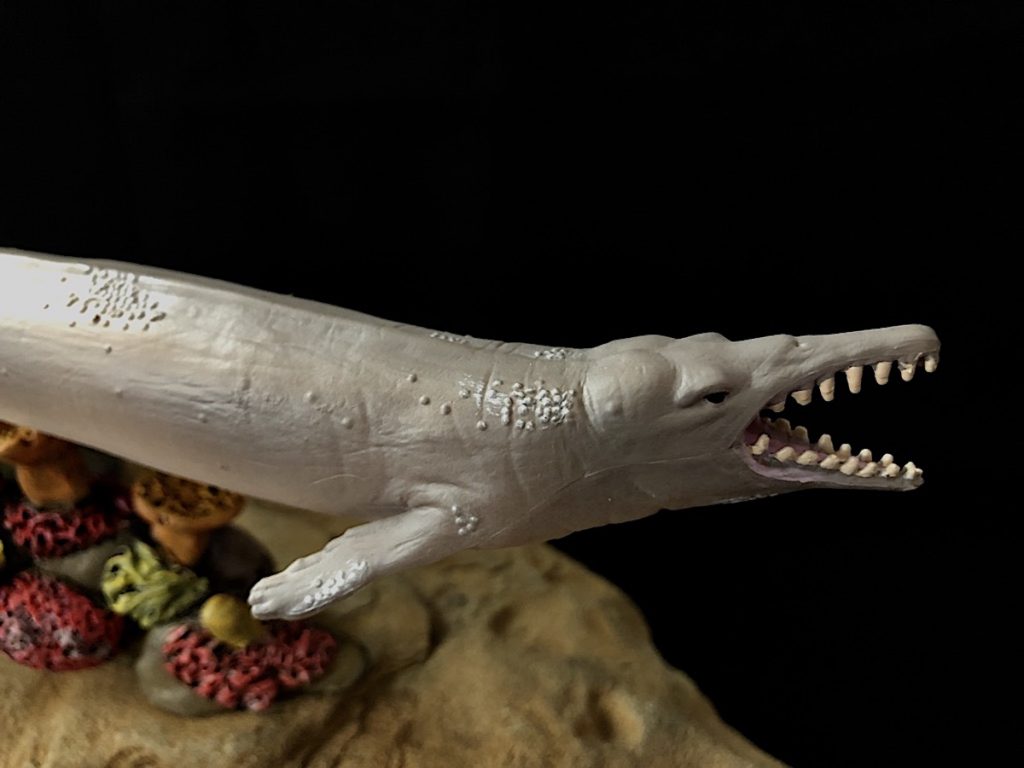
Whales in general are smooth skinned creatures. To add some textures on the skin, CollectA added some parasitic barnacle-like creatures scattered along the back and underside. This really gives the figure some much needed texture and adds another layer of realism to the figure. We see this type of parasitic infestations in modern whales, so it is likely that Basilosaurus also had them at some point in their life. I really love how CollectA add these little details, it really sets the figures apart making them unique, and it adds a whole different layer of story to the figure.
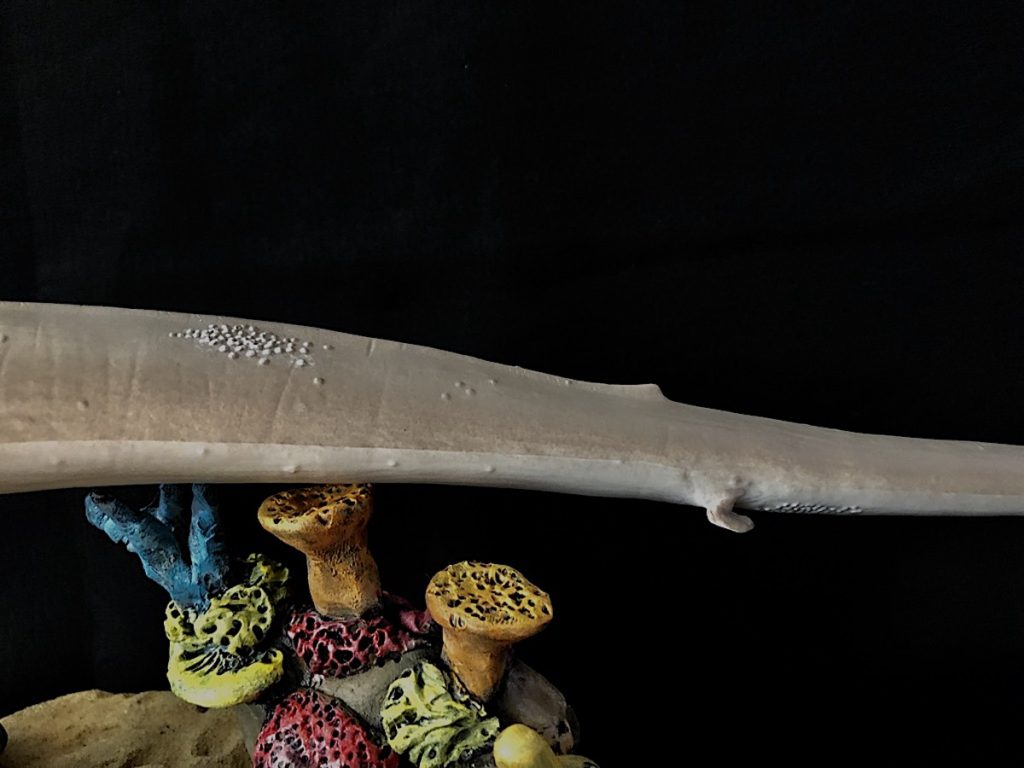
Besides the parasites, there are skin folds around the neck area as well as the fluke/shoulders. There are fine wrinkles along the length of the body as well.
The front flippers are nicely sculpted and you can see some evidence of digits. Both front flippers also have some parasites attached to them.
Basilosaurus did not completely lost it’s hind legs, but now those limbs are just a small vestigial. These can be seen in the figure as well. It is not completely known if these hind flippers have any function, but mating is a likely one.
Basilosaurus has an eel-like body shape. This resulted in it being often depicted as swimming like an eel with too many, and extremely ( and unlikely ) curved fashion. More likely, it swam mostly on the surface with a simple method of swimming. The body design of Basilosaurus made it unlikely that it can dive deep. The fossil evidence suggest that the tail had a fluke, which further support the idea of it being a simple swimmer.
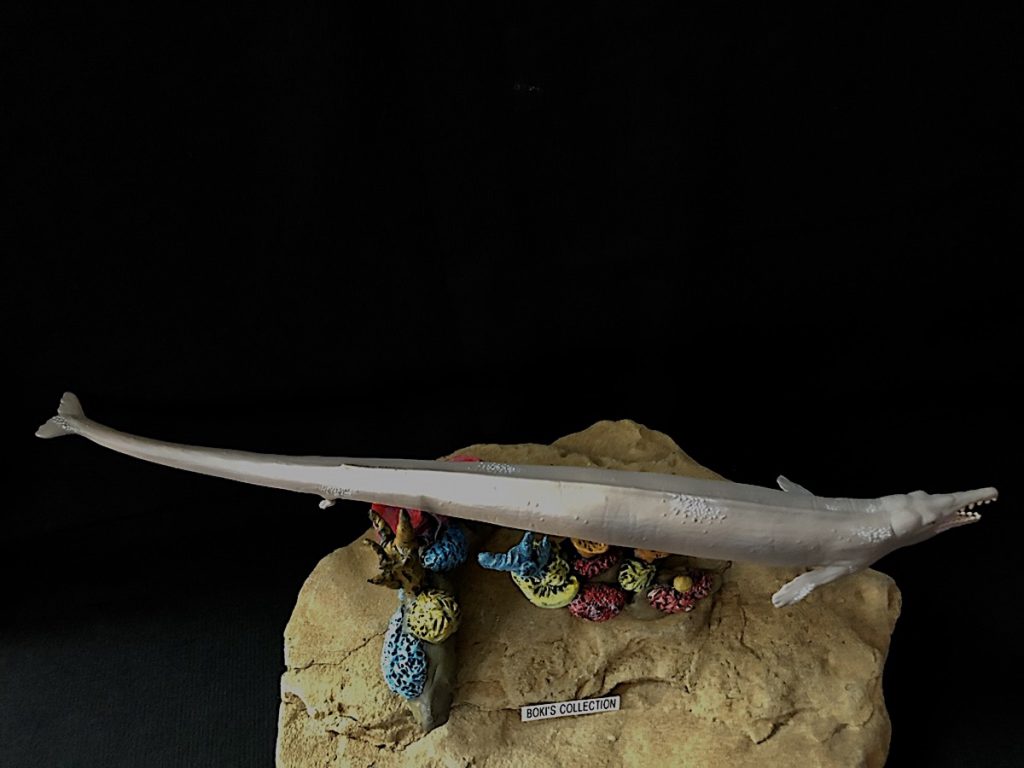
The figures tail is small and also show some barnacles growing on one side.
The back shows a slight ridge that runs along the spine starting at the base of the neck and terminating as it reaches the the base of the dorsal fin, which is very small.The coloration is a simple grayish brown on the top part of the body, and cream/white on the underside. It’s a simple yet possible coloration for an oceangoing animal.
During it’s time, it reigned the worlds ocean, terrorizing smaller whales like durodon. There are fossil evidence of the much smaller whale Dorudon having bite marks that matches that of Basilosaurus. The two species of Basilosaurus may have preferred different prey, with one preferring much large prey such as whales and the other showing preference to smaller ones like sharks and fish.
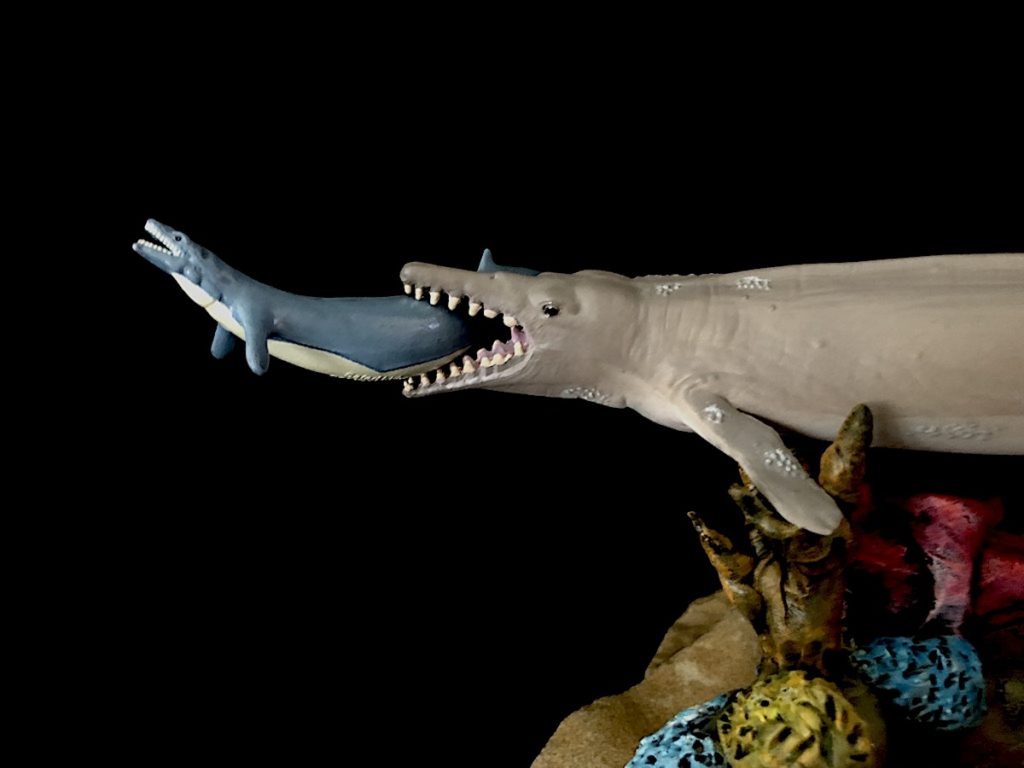
The shifting continents and cooling of the worlds ocean was happening too quickly for Basilosaurus to adapt. In the end, it, like many dynasty before and after it, Basilosaurus’s reign on the worlds oceans came to an end. Along with its relatives, it, too, went extinct, leaving the oceans empty and ready for a whole new cast of characters to rule.
Today, all that remains of this once mighty predator are its fossilized bones. They litter the deserts that was once part of a vast ocean that covered the globe.
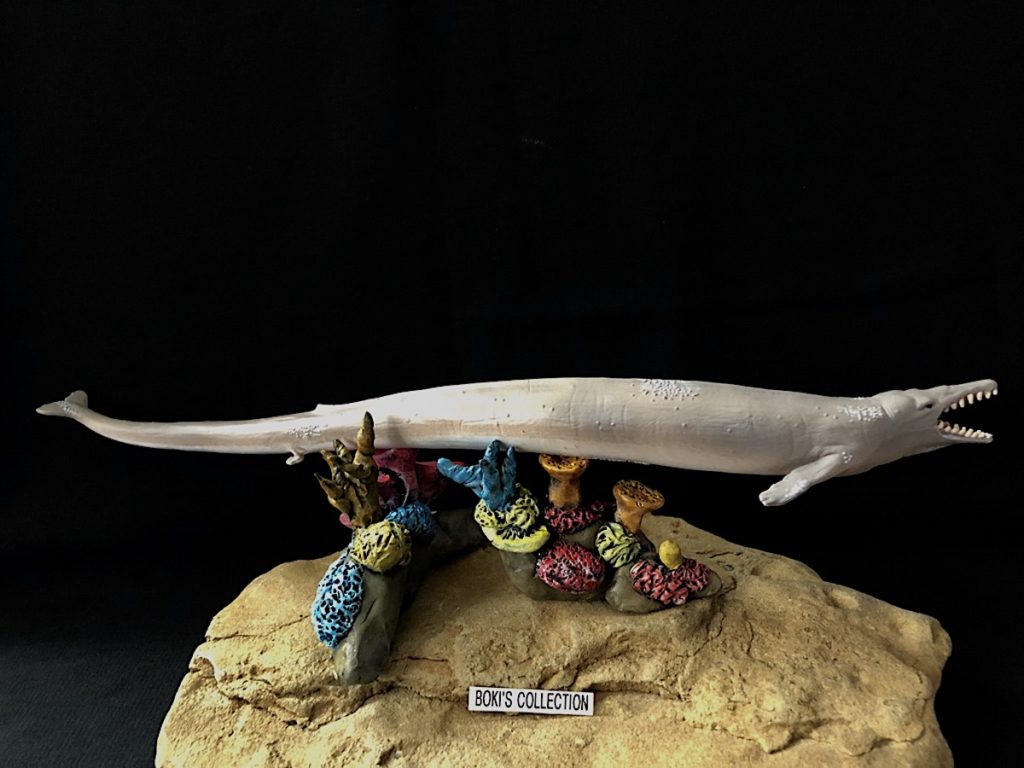
In closing, I really like this figure. It is one of the handful of prehistoric whale figures that are out there. If you like prehistoric mammals, or interested in whale evolution, I highly recommend this figure. Hopefully, we can see more ancient whales in the future.
Hope you enjoyed the review, thanks for reading and till the next review, Cheers!
Disclaimer: links to Ebay and Amazon on the DinoToyBlog are affiliate links, so we make a small commission if you use them. Thanks for supporting us!




Sad to say there were a few details that prevented me from adding Basilosaurus to my collection. The skull with what appears to have enlarged teeth and a bulbus for head, and the barnacles and parasites along its flanks creep me out. Sorry CollectA.
In the picture with multiple basilosaurus figures, what are the 2 at the bottom?The spotted and silvery ones.
I do not like this one. They did not have a melon, they were indeed very slender, but the poor thing is completely shrink-wrapped. You can see the back of its skull, eye ridges, and the teeth are completely bare with no lips.
Whales have lips (have you seen a beluga?), even the killer whale’s impressive dentition is almost hidden behind the upper lip, hanging like a curtain around the big chompers. All mammals have lips, there is no reason to think the ancestors of moden whales lacked them.
It is appreciated that Collecta made that magnificent basilosaurus, although I have to admit that I like his PNSO counterpart more. The basilosaurus of Collecta is a detailed figure but honestly what I find in this figure is that it lacks a size that competes with its Deluxe del Collecta counterparts. The teeth are quite blunt and although it is my only marine prehistoric mammal with a decent size on my shelves, I hope that some day Collecta will make an improved figure of this emblematic whale.
In this honestly I would like a basilosaurus by Collecta larger and more in line with the category that this beautiful cetacean has in the world of paleontology.
Thank you for reviewing this beautiful beast! I come from the Philippines, where the only generally available dinosaur toys are Schleich and Mattel. On rare occasions some obscure pieces do turn up in our Japanese flea market surplus shops, though! I found a tiny basilosaur there once: the silver-black one with the serpentine arch in your group photo. Pray tell, what brand is it from?
Hi there! Hey, I’m from the Philippines,too!
Great to see a kababayan on the blog!
The figure you are asking about is a Japanese company, I believe it’s Gakken and was part of a set called mystery creatures.
I hope you still have yours, it’s a hard figure to acquire and they are not very easily found.
Wow! How serendipitous! I am all the more amazed that you are able to acquire these wonderful specimens, given the slim pickings in our corner of the globe. Yes, I still have mine – it has a mysterious hole on the underside, I presume for some sort of stand. Thank you for your response, good sir, and may we hopefully run into each other someday in similarly pleasant circumstances!
A fantastic piece and a wonderful review!
Thanks so much.
Excellent review and photos! It’s also worth noting that Basilosaurus possessed the strongest bite force of any known mammal.